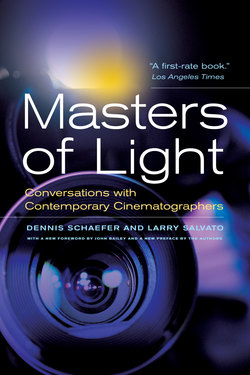Читать книгу Masters of Light - Dennis Schaefer - Страница 12
На сайте Литреса книга снята с продажи.
Оглавление4
Bill Butler
"The day-to-day business of making movies is a matter of problem solving. You are constantly problem solving from the time you arrive on the set until you quit shooting in the evening.”
Bill Butler has a habit of jolting people by casually mentioning that he’s working on his third career. His youthful and energetic outlook tends to obscure the fact that he did a stint in radio, moved on to a distinguished career in Chicago television and then finally made the transition to Hollywood filmmaking in 1969. And while many creative people might have burned themselves out along the way, Butler is probably now turning out the most significant work of this three careers.
After receiving a degree in engineering, Butler worked in radio for a short time but quickly moved on to what turned out to be the ground floor in a similar but new medium—television. In fact, he helped to construct the first commercial TV station, WGN in Chicago. After getting the station on the air, he remained in an engineering capacity until one day, by some quirk of fate, he got behind the television camera. Ever since then Butler has been artistically hypnotized by that image in the camera viewfinder.
Working at WGN also laid the groundwork for an important personal and professional relationship that continues to this day. While Butler was a cameraman at the station, WGN hired a new kid in the mailroom, named Billy Friedkin. Friedkin showed some innate talent and was soon directing television shows there. Both men were interested in the dramatic power of film. At Friedkin’s urging, they worked as a team, moonlighting on film projects for church groups and public service organizations. Several of their documentaries won film festival awards. Friedkin moved to Hollywood to test his directing mettle and Butler was to follow later.
Beginning with his first Hollywood feature, Francis Coppola’s The Rain People, the number of directors Butler has worked with has expanded to the point where it reads like a Who’s Who of Directors. Among the more prominent names are William Friedkin, John Boorman, Jack Nicholson, Phil Kaufman, John Korty, Francis Coppola, Irvin Kershner, Milos Forman and Steven Spielberg. Butler has also shot the first features of some younger, talented directors like John Badham and Randall Kleiser. His versatility has been proven in his ability to bring a specific style to “important” pictures like The Conversation and Drive, He Said as well as to lighter fare like Alex and the Gypsy and Grease. Two films photographed by Butler, Jaws and One Flew over the Cuckoo’s Nest (co-credit with Haskell Wexler), have between them earned over a quarter of a billion dollars.
The secret to Butler’s success is that he is a consummate professional in anything he does. After little more than a decade of shooting features, he has compiled a track record and a list of credits that any student cinematographer would aspire to and that even a veteran cameraman would envy. It makes one wonder what Butler is planning for his fourth career.
How do you choose your film projects?
